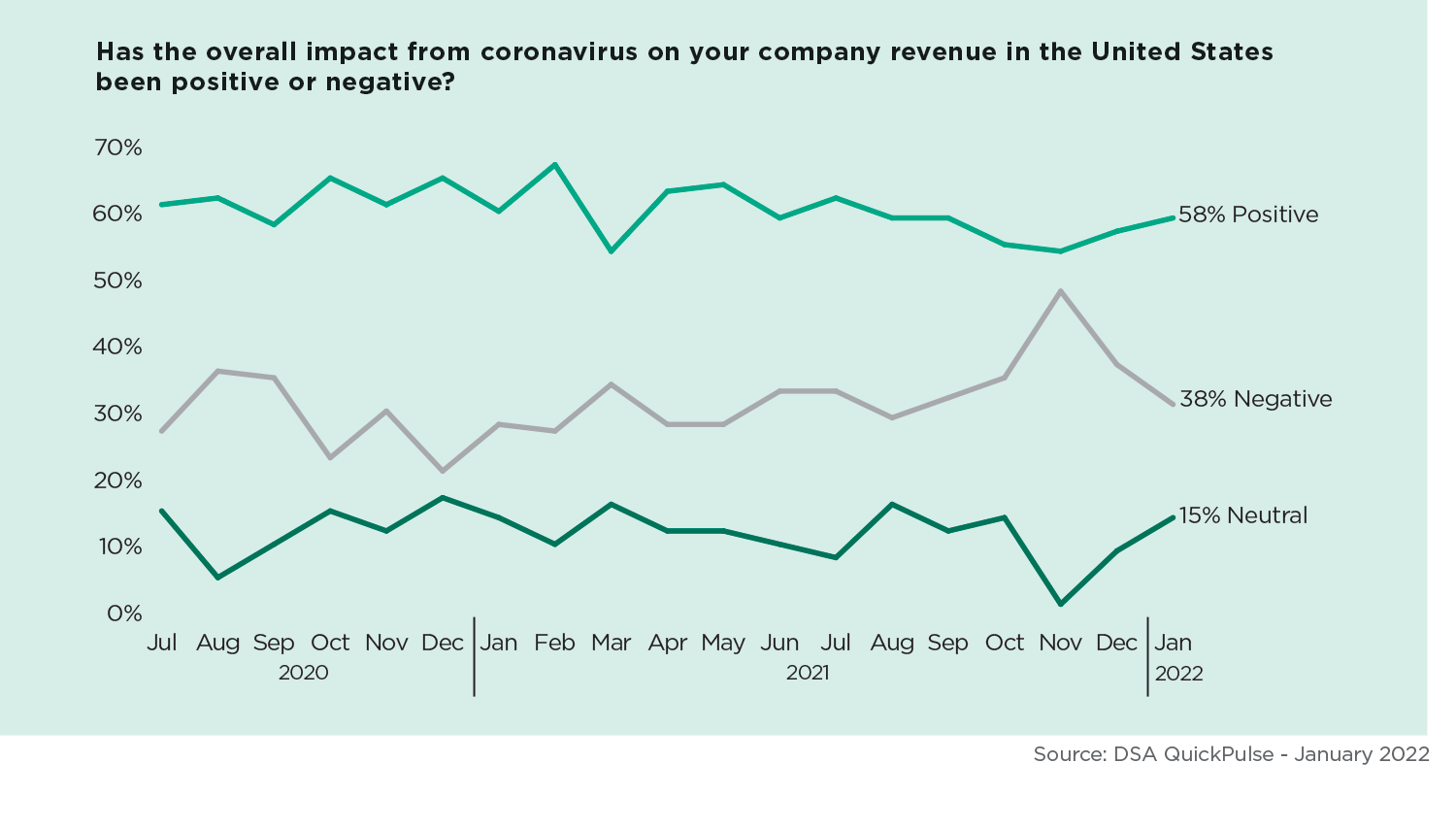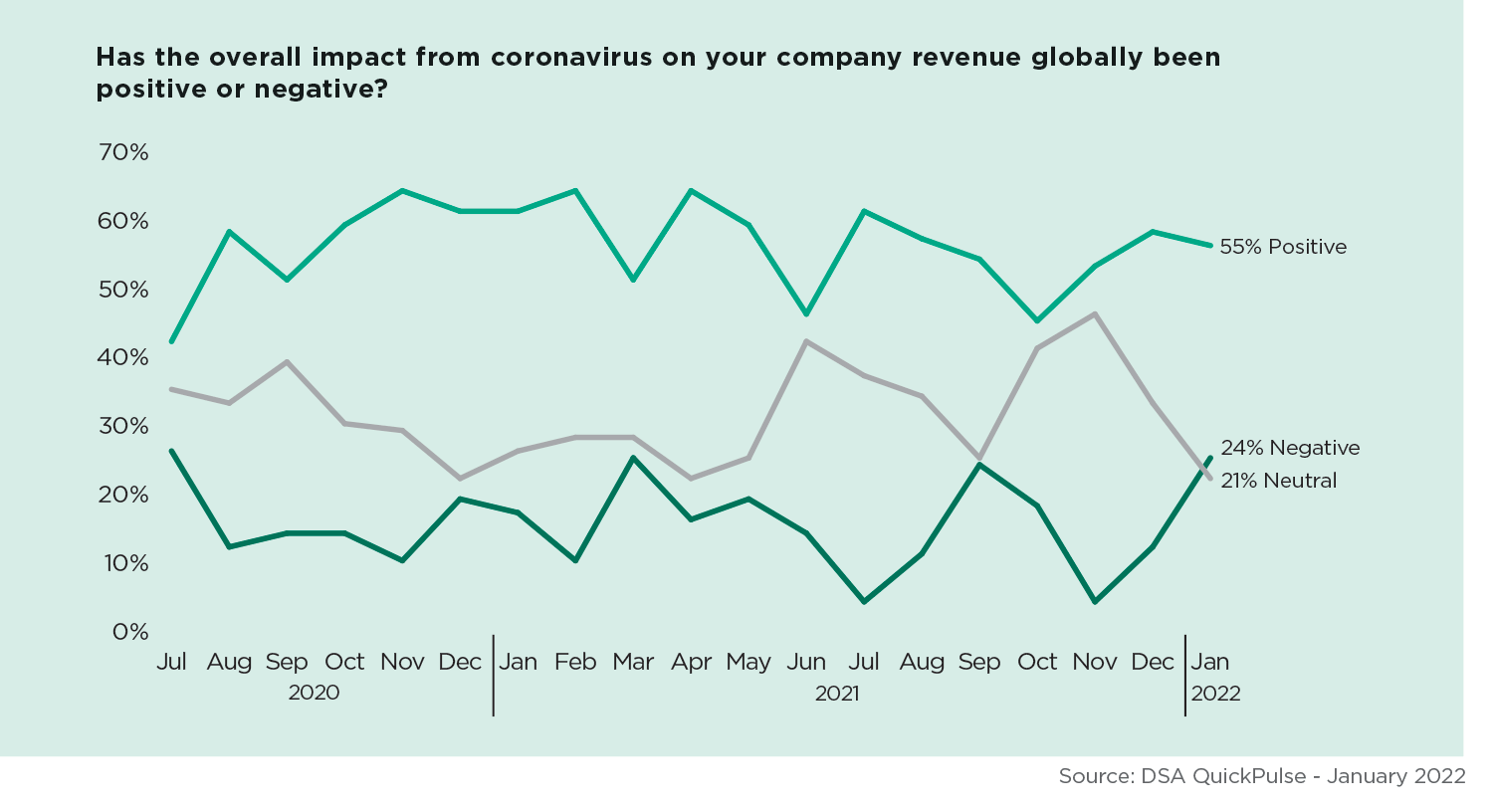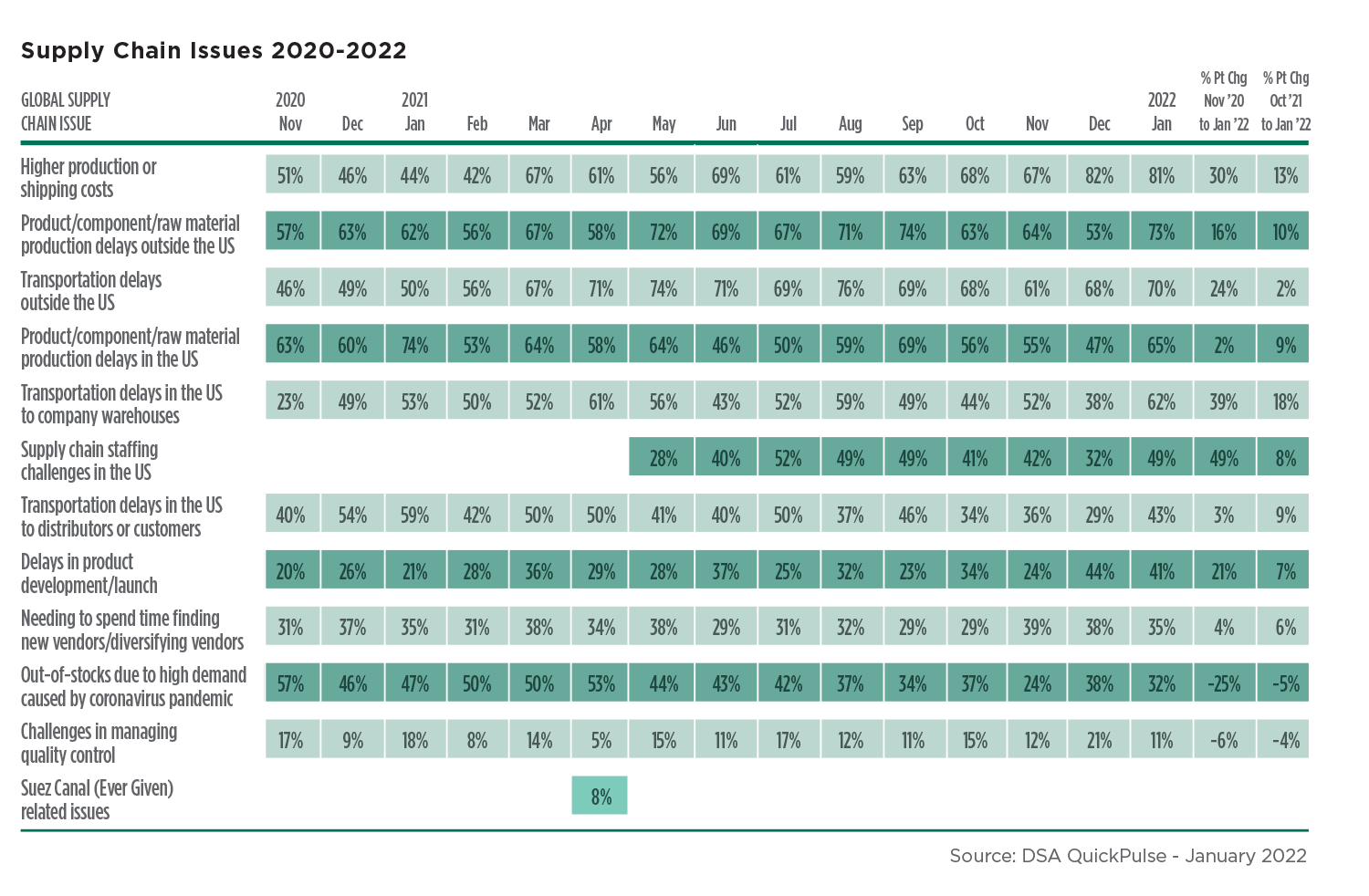Two years after it began, COVID-19 continues to impact businesses around the globe. DSJ looks at three of the major impact points as they relate to direct selling: consumers, company revenue, and supply chain. Jay Walker Smith, one of America’s leading analysts on consumer trends, addresses current consumer sentiment and the key imperatives for growth. DSA’s Research Committee provides recent and historical data that shows the challenges direct selling leaders face in relation to growing revenue and navigating supply chain issues.
The Impact on Consumers
At Kantar, our specialties are trends and futures. We have been tracking consumer values and attitudes in the US and globally for several decades. I want to give our perspective on key priorities for unlocking opportunities in the consumer marketplace as we look ahead—not direct selling, per se, but rather an over-arching view of the entire market context.
There are several areas ready to boom, but to get there, we’re going to need to provide leadership and guidance for consumers. So first, let’s take a look at where we stand in the marketplace and where we should look next for growth and success.
Let’s start with the bottom line. Consumers have money to spend, and it is well beyond what they have normally. There is unspent savings that they have accumulated during the pandemic to the tune of $2.5 trillion in the marketplace, but they haven’t spent it and that’s only partly because of the Delta variant. Most just haven’t found the right things to spend it on because we are not connecting with them properly. So the question is this: What are consumers looking for?
Let me share a recent news story about a man in Turkey. He was at a bar with a bunch of friends. When they all left, this man wandered off into the woods. When his friends couldn’t find him later that night, they called the police. A search party was organized. Not long after, the man ran across the search party in the middle of the woods and actually joined the search party, not knowing who he was actually searching for. He did not realize they were searching for him until someone called out his name. So he found himself if you will, and all ended well.
I see that story as a metaphor for where consumers are these days. We are all in transition, searching for ourselves, and opportunities will be found in the things we are searching for.
What are these things we have lost? We’ve lost our cool, we’ve lost our balance, and we’ve lost our way. We have lost our peace of mind and our sense of security. We have lost our equilibrium and our sense of well-being. And we have lost our sense of stability and confidence and predictability about the future.
That leads to three key imperatives for growth. The first is accountability: being more open and responsive to more demanding consumers. The second is resilience: being more supportive of consumers on their journey of discovery and their redefinition of their lifestyles. And finally, transformation: recognizing the need for bigger bets in a highly disruptive future that will require bolder thinking than just the kind of incrementalism that has sufficed in the past.
And those are three key takeaways. Double down on transparency and responsibility, dial up the focus on wellness and experience, and look for more out-of-the-box opportunities.
Let’s start with accountability, which is this idea of less forgiving consumers. They are more charged up—to the point of being brittle and unforgiving. Indeed, we’ve seen all the headlines about people being angry and acting out in public. And in our tracking data, two-to-one consumers are telling us they feel people are behaving worse than they did before the pandemic. These are people who have been there on site when these instances are occurring.
This translates into commercial implications. As the American Consumer Satisfaction Index has found, people’s perceptions of brands and service providers are at their lowest level in the past fifteen years. Consumers simply want more. However, we do think that this dissatisfaction in the marketplace and these angry emotions have peaked a little bit. Gallup tracks negative emotions in the marketplace, and what they have found is that they were at their highest levels ever during the pandemic. A year later that has reversed; now they are at their historically lowest levels ever.
What’s going on in the marketplace is not whether consumer sentiment is high or low. It is simply this enormous volatility that is going on in the marketplace. You even see this in Gallup data with the percentage of people in recent years who have told us that they are thriving or not thriving. There’s been lots of volatility. We see this in our Kantar monitor data as well when we ask about risk aversion and risk interest among consumers. More volatility in these attitudes than ever.
And that’s the story of consumers in the marketplace—not up or down, per se, but this volatility in attitudes. Consumers going up and coming down. What they are looking for is something that is more accountable, something that is more of a stabilizing force in their lifestyles, brands that are committed to the kind of transparency and responsibility that consumers can turn to in order to find some stability in this more volatile environment. In particular, that means de-risking engagement in the marketplace. Consumers want to take some risk out of what it means to engage in the marketplace so they can unlock some of that excess savings they have and engage with brands.
There are several key things that we must do in order to de-risk the marketplace for consumers. One of those is just to lean into our brand equity, or the reassurance of brand heritage. We have seen this before. In our brand Z tracking just released this year, we saw year over year the biggest increase in brand value for the top 100 companies that we have ever measured in our brand Z tracking. It was a 42 percent increase in brand value year over year, which is simply reflective of the fact that consumers, during this time of disruption and just as they have done in the past, are turning to brands that can leverage heritage and equity to provide them with some reassurance to de-risk engagement in the marketplace.
But it is more than just heritage. And heritage, in fact, is not an excuse to do nothing. We must also over-service and over-deliver to consumers. They are actually looking for new coping skills. They need help. They need solutions. They want self-protection. They need more tools to be self-reliant. They want things that can help them solve problems. They want to avoid risk. They want to feel more resilient in their lifestyles and in the ways in which they are engaged in the marketplace.
They want brands that can help them in this time of disruption. And that translates into certain expectations about the marketplace, both for brands and retailers. They want brands that are going to be available, that are going to make it easy for them to engage, and that are going to make it possible for them to get and deal with anything they need in the marketplace in an easy, convenient, and non-stressful way. This means over-delivering and over-servicing brands and consumers in the marketplace.
De-risking means standing up for the community. That is, showing your commitment to the place where consumers find themselves during this time of disruption. This is true across generational cohorts. Consumers are telling us that they believe companies are doing more to help everyday people right now than the government is. They see companies as the resource they want to turn to. They see companies as the place that they can find the accountability that will de-risk this engagement in the marketplace.
This then takes us to the related element of resilience. And this, of course, arises from the fact that consumers are facing less forgiving challenges in the marketplace. They’re not just losing their cool in today’s environment; they are losing their balance as well. And what they face is an overwhelming marketplace that is disrupting their balance and their lifestyles.
We have heard all about mental health during this time, but it’s a bigger deal than is generally recognized. Center for Disease Control (CDC) data shows the jump in people reporting anxiety disorders from 2019 to 2020. It is over a threefold increase. That’s the balance that people have lost. And while this is getting better, we still have a long way to go.
And it’s not just mental health. We know that people’s work styles are being disrupted as well. There are disruptions coming from hybrid work. And there are other kinds of disruptions going on, too, like the Great Resignation, consumers looking for new skills, employers having to move into different areas. All of this is creating work disruptions that are piled on top of the other kinds of lifestyle challenges and mental health challenges that people are facing as well. And so, what people are looking for is some resource of resilience, something to get them back into balance.
There are a lot of new routines and new households arising from these lifestyle shifts. And so, people want brands that are going to do a better job of responding to the different ways in which they are living these days. But it goes beyond that, because people are also looking for more resources to be able to help themselves and to care for themselves. And this is actually a long-term trend. Google search data is illustrative of the interest people have in things that can enable them to do a better job of taking care of themselves. It was particularly during the pandemic year.
All of this accountability and resilience adds up to fundamental transitions in the marketplace for brands because it is a less-forgiving marketplace than ever before. In particular, it is going to be a marketplace characterized by more volatility and more uncertainty than we have been used to in the past.
What this says is that we need to make transformative leaps, not just more incrementalism. The pandemic has made this clear, and this is what it’s going to take for brands to measure up to this future with consumers who are looking for more accountability and more resilience. It’s a marketplace that is going to demand more from us but is going to pay off in bigger rewards when we lean into these kinds of opportunities.
The Impact on Company Revenue
Each month since July 2020, DSA’s Research Committee has released QuickPulse, a tracking survey designed to help understand the impact of the pandemic specific to the direct selling channel. The monthly survey is intended to help companies navigate the challenges posed by the pandemic and recovery and to better understand overall business, supply chain, and inflation impacts to the industry.


The Impact on Supply Chain
January 2022
The following data represents results of DSA’s January QuickPulse Survey, which was fielded between January 3-9. Of the forty companies participating, 25 percent were companies with more than $250 million in annual net sales, 15 percent were companies with $100–$250 million in annual net sales, 48 percent were companies with $10 million–$100 million in annual net sales, and 13 percent were companies under $10 million in net sales.
- Nineteen in twenty companies (95%) indicate they are experiencing global supply chain issues. Of those experiencing issues, 87% say the issues are having a moderate or significant impact on their business in the United States.
- Compared to three months ago, 51% say supply-chain disruptions are impacting their business about the same, 32% say supply-chain disruptions are impacting their business more, and 16% say supply-chain disruptions are impacting their business less.
- Of respondents, 55% anticipate general supply-chain disruptions will continue for six or more months, 35% anticipate they will continue for 5-6 months, and 10% anticipate they will continue for 3-4 months.
- The top five supply-chain challenges of direct selling companies in January are:
- Higher production or shipping costs (81%)
- Product/component/raw material production delays outside US (73%)
- Transportation delays outside US (70%)
- Product/component/raw material production delays in US (65%)
- Transportation delays in US to company warehouses (62%)
More than 60% cited each as an issue in the January survey.
